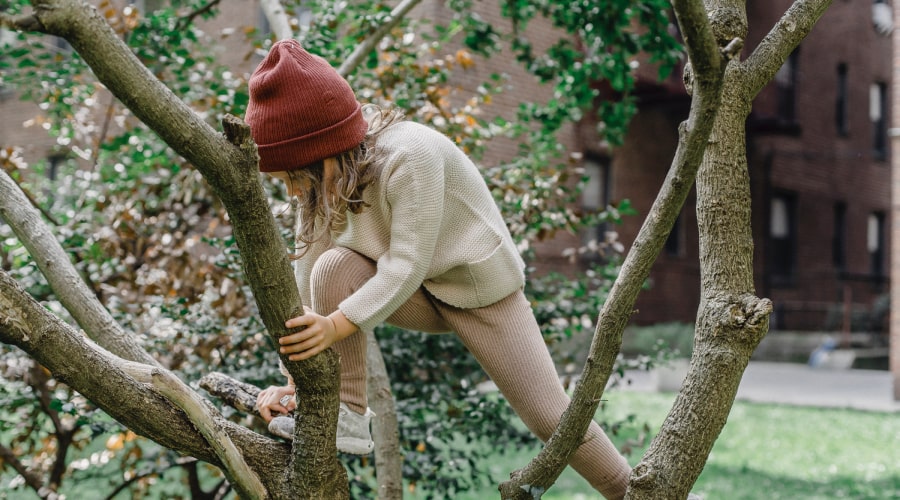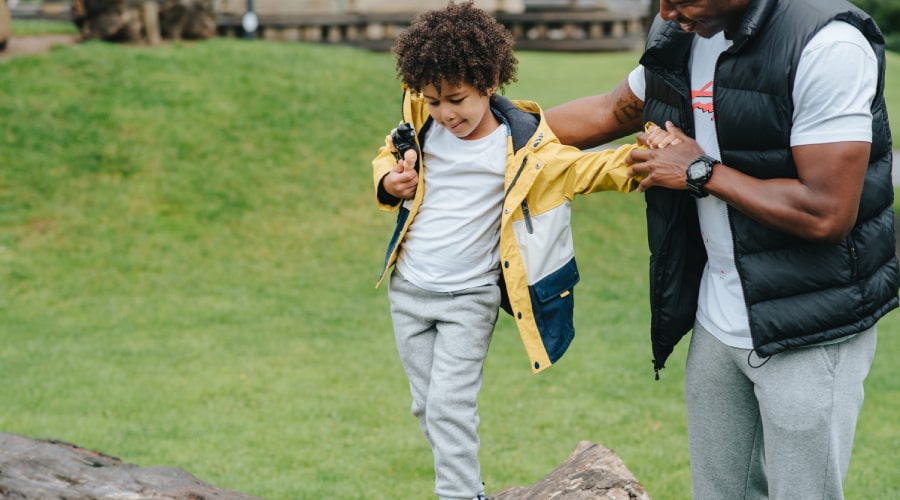settings
children
With Famly since
At a preschool in Sweden, a young boy is standing with his arms crossed and feet wide apart on a big rock, shouting that he is the captain of a pirate ship sailing across the ocean. Below him, a handful of other boys are scurrying around, watching for enemies and reporting their sightings back to the captain through pretend walkie-talkies.
They’re deeply engaged in sociodramatic play.
The forest is an environment that lends itself well to this kind of play, where a group of children assume different roles and characters in imaginary worlds or recreate situations that they have experienced in real life. But you don’t have to take to the woods to encourage children’s imaginative play and social interactions. By being intentional about landscaping and including a few key design elements in your outdoor space, you can create a more natural environment that supports sociodramatic play, whether at a daycare, preschool or your own backyard.

What’s the big deal about sociodramatic play?
Sociodramatic play is the most complex form of dramatic play, since it involves interacting with at least one other child. Children typically begin to engage in this type of play around the age of three and it becomes more and more common in the preschool years.
Kimberly K. Cloward Drown, a landscape architect whose masters’ thesis investigated the best outdoor spaces for imaginative play for preschoolers, identifies a slew of skills children learn through sociodramatic play:
- It helps them process their thoughts and develop an understanding of themselves and their surroundings.
- It helps them develop emotional intelligence and advanced cognitive abilities like planning, meta communication, goal setting, problem solving, negotiation and coordination.
- It fosters creativity, imagination, and better social skills.
- It encourages abstract thinking, which prepares them for academic work.
- It helps impulsive children develop self-regulation.
- It supports early literacy, as it puts writing in a context that makes sense to them.
How to enhance opportunities for sociodramatic play outdoors
Traditional outdoor play spaces for children typically center around a few fixed, manufactured play structures made of plastic and metal. Often, the structures have a set theme and a prescribed use, which can limit children’s creativity and imagination, as well as their ability to challenge themselves. A better option to encourage sociodramatic play, according to a host of architects, pedagogues and environmental psychologists, is to offer more natural play spaces where children can manipulate and engage with the environment hands-on.
Natural playgrounds take advantage of existing topographical features to create spaces for open-ended, self-directed play. These dynamic outdoor spaces offer plenty of opportunities for children to do all the things that they naturally gravitate towards – hide, climb, dig, run, crawl, swing, and play with loose parts. They also trigger their curiosity and imagination, as they can explore with all their senses and engage hands-on with different materials.
In her study, Cloward Drown tracked children’s activity at a traditional playground versus a natural playground and found that the children engaged in more complex sociodramatic play in the natural surroundings, although often in combination with man-made objects. Turns out that by combining both, you can get the best of both worlds. The difference was most pronounced for complex sociodramatic play, which involves acting out a sustained theme using advanced symbolism. As much as 91 percent of the total complex sociodramatic play occurred at the natural playground. Previous studies also support the idea that a more natural environment can help strengthen children’s dramatic play experiences.

Making space for sociodramatic play in the outdoors
So how do you enrich children’s outdoor play spaces to encourage dramatic and complex sociodramatic play? Try these tips:
Plants. Trees, bushes and plants can both provide rich sensory experiences and become props and backdrops for children’s imaginative play. For example, a circle of sunflowers or a bean tipi can make for an excellent play space in the summertime, while a playhouse or tunnel made of evergreen creepers or willow trees is a more permanent structure that can be used all year. Smaller plants with interesting seed pods, colorful flowers or stalks that can be used for building are also excellent props for play.
Loose parts. Items that children can move and manipulate are generally more useful to dramatic play and offer more flexibility than fixed objects. A stick can be a wand, ladle, writing tool, sword, fishing pole and much, much more. All loose parts don’t have to be natural, however. Plastic milk crates and car tires are open-ended materials which can be moved, stacked, torn down or turned into furniture and other props during dramatic play.
Enclosed and semi-enclosed structures. “Secret” places, especially those with a ceiling but even strategically placed walls of greenery, can give children the opportunity to act out their roles in privacy. If the enclosed place has an open floor, all the better. A floor can become a stage for children, where they shape their play by assembling and structuring loose parts the way they want it.

Defined spaces. Both large, open areas where children engage in gross motor activities, like a track for riding tricycles or a field for ball play, and quiet places can support social play. But the most inclusive and favorable setting for sociodramatic play seems to be quiet, natural environments that are away from the areas with gross motor activities. A playground that includes both these types of spaces but keeps them clearly separated seems to be what children gravitate to for dramatic play.
Natural surroundings. The more topographically varied and ecologically diverse the playground, the better the opportunities for dramatic play. Unlike manufactured play equipment, natural features like logs, rocks, water and vegetation are not locked into a particular use but can take on different meanings to fit into children’s dramatic play theme.
Keep in mind that regardless of environment, dramatic play is not very common when compared to other forms of play (13 percent of the total observed play time in Cloward Drown’s study). If the children themselves don’t initiate dramatic play, you can always encourage it through gentle guidance. Use some props to set up a simple, impromptu scene, for example a vet’s office, rocket ship or restaurant, and see if anybody wants to join in. Thoughtfully done, adult-supported dramatic play can lead children to engage in even more complex sociodramatic play – and that can be a big win for their development. Plus, it’s fun!
The big ideas
Top tips from Reynolda Preschool
Get top tips from a preschool just like yours. Hear from Reynolda Preschool on why and how they use Famly - and why they’ve never looked back.
Read their story









